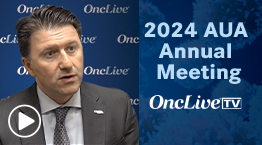Anti–LAG-3/PD-1 Combination Under Investigation as Adjuvant Therapy in High-Risk Melanoma
The combination of fianlimab and cemiplimab represents a wave of novel anti–LAG-3/PD-1 treatments being explored in patients with melanoma at high risk for relapse.
Timothy J. Panella, MD

The combination of fianlimab and cemiplimab-rwlc (Libtayo) represents a wave of novel anti–LAG-3/PD-1 treatments being explored in patients with melanoma at high risk for relapse, according to the rationale and design of an ongoing phase 3 trial (NCT05608291) that were presented at the 2023 ASCO Annual Meeting.1
“The longer relapse-free survival [RFS] and lower toxicity has made PD-1 inhibitors the standard of care as adjuvant therapy in patients with high-risk melanoma,” Timothy J. Panella, MD, of the University of Tennessee Medical Center at Knoxville, said during a presentation of the trial in progress. “Despite these recent advances, a significant portion of patients will relapse. Hence, for patients with resectable high-risk melanoma, there is a high need for a treatment that is more efficacious than anti–PD-1 monotherapy with good tolerability.”
The immune checkpoint receptor LAG-3 is a potentially relevant therapeutic target in melanoma because it suppresses cytokine secretion and T-cell activation. Previously, in the phase 2/3 RELATIVITY-047 trial (NCT03470922), the fixed-dose combination of the LAG-3 inhibitor relatlimab-rmbw plus the PD-1 inhibitor nivolumab (Opdualag) produced a median progression-free survival (PFS) of 10.1 months compared with 4.6 months with nivolumab alone in patients with treatment-naïve metastatic or unresectable melanoma,2 leading to the 2022 FDA approval of the combination in this population.
Subsequently, a phase 1 first-in-human study (NCT03005782) demonstrated that in patients naïve to PD-1/PD-L1 inhibitors, the LAG-3 inhibitor fianlimab plus the PD-1 inhibitor cemiplimab generated an overall response rate of 63.8% and a median PFS of 24.0 months. The median duration of response was not reached in this population.3
Supported by these findings, investigators designed a randomized, double-blind, 3-arm, phase 3 trial to evaluate the efficacy of the fianlimab/cemiplimab combination vs pembrolizumab (Keytruda) monotherapy in patients with completely resected high-risk melanoma.1
This trial plans to enroll approximately 1530 patients at least 12 years of age with histologically confirmed, surgically resected stage IIC, III, or IV melanoma. Patients with stage IIIA melanoma need to have 1 or more micrometastasis in the lymph nodes with a diameter of over 1 mm. Up to 10% of the total trial population can consist of patients with acral or mucosal melanoma. Patients must have undergone complete surgical resection of their melanoma within 12 weeks prior to enrollment and need to be disease free within 4 weeks prior to enrollment. Patients are not permitted to have received prior systemic or radiation therapy for melanoma in the 5 years prior to enrollment, with the exception of patients with stage IV M1d disease, who may have received radiotherapy to the central nervous system after radical resection. In addition, patients need to have an ECOG performance status of 0 or 1, as well as a Karnofsky performance status or Lansky performance status over 70 in patients older than 16 years and younger than 16 years, respectively. At minimum, all patients must provide 25 slides or 125 mm3 of a resected tumor tissue sample.
Patients will be excluded if they have: uveal melanoma or evidence of residual disease following surgery per imaging, cytology, or pathology; evidence of clinically significant autoimmune disease that is ongoing or has occurred within 2 years prior to enrollment and required systemic immunosuppressive treatment; another malignancy that is currently progressing or required active treatment within 5 years prior to randomization; received prior anticancer therapy, including chemotherapy, immunotherapy, biological therapy, or major surgery within 5 years prior to randomization; received immunosuppressive corticosteroids amounting to over 10 mg of prednisone daily or an equivalent treatment, within 14 days prior to receiving the first dose of study treatment; and current evidence or history of significant local or systemic infection, defined as Common Terminology Criteria for Adverse Events grade 2 or higher, that required systemic antibiotic treatment within 2 weeks of receiving the first dose of study treatment. Adolescent patients, defined as those at least 12 years to under 18 years of age, who weigh less than 40 kg will also be excluded.
Patients will be stratified by disease stage (stage IIIA vs IIC-IIIB-IIIC vs IIID-IV[M1a/b] vs IV[M1c/d]) and geographical region (North America vs Europe vs Rest of World).
Patients will be randomly assigned 1:1:1 to receive fianlimab at dose 1 plus cemiplimab at 350 mg every 3 weeks intravenously (IV; arm A), fianlimab at dose 2 plus cemiplimab at 350 mg every 3 weeks IV (arm B), or pembrolizumab at 200 mg plus saline or dextrose placebo every 3 weeks IV (arm C). Patients will remain on the study treatment for 1 year.
The full analysis population, which will be used for efficacy analyses, will include all randomly assigned patients. The safety analysis population will include all randomly assigned patients who received any study drug.
The primary hypothesis of this trial is to demonstrate the superiority of fianlimab at either tested dose level plus cemiplimab over pembrolizumab as adjuvant treatment for patients with high-risk melanoma. The primary end point of this trial is RFS, with secondary end points including overall survival, melanoma-specific survival, distant metastasis-free survival, quality of life, safety/tolerability, the pharmacokinetics of fianlimab plus cemiplimab, and the immunogenicity of fianlimab and cemiplimab.
This study is open for enrollment.
Disclosures: Dr Panella reports no disclosures.
References
- Panella TJ, Thomas SS, McKean M, et al. A phase 3 trial comparing fianlimab (anti–LAG-3) plus cemiplimab (anti–PD-1) to pembrolizumab in patients with completely resected high-risk melanoma. J Clin Oncol. 2023;41(suppl 16):TPS9598. doi:10.1200/JCO.2023.41.16_suppl.TPS9598
- Tawbi HA, Schadendorf D, Lipson EJ, et al. Relatlimab and nivolumab versus nivolumab in untreated advanced melanoma. N Engl J Med. 2022;386(1):24-34. doi:10.1056/NEJMoa2109970
- Hamid O, Lewis K, Weise A, et al. Phase 1 study of fianlimab, a human lymphocyte activation gene-3 (LAG-3) monoclonal antibody, in combination with cemiplimab in advanced melanoma. Ann Oncol. 2022;33(suppl 7):S7905. doi:10.1016/j.annonc.2022.07.916




